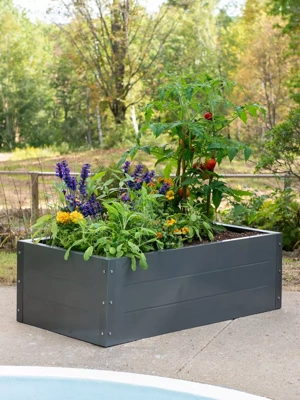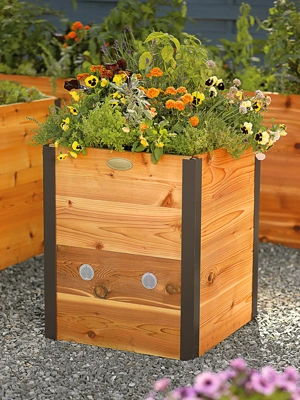Pollinator Garden Plan: Bees
Designed for our raised Pollinator Garden Bed
 This planting plan features flowers to attract a variety of bees, including honeybees and native bees. It's designed for our Pollinator Garden Bed but the plan is perfect for any small-space planting.
This planting plan features flowers to attract a variety of bees, including honeybees and native bees. It's designed for our Pollinator Garden Bed but the plan is perfect for any small-space planting.In addition to the familiar honeybee, there are hundreds of native bee species that are also important pollinators. This garden puts out the welcome mat for bees and other beneficial insects.
While the bees are sipping nectar and collecting pollen, you'll enjoy a beautiful raised bed garden that produces flowers in every season, spring through fall.
Most of the perennial varieties were chosen for their relatively compact form so they won't overwhelm the bed once they reach their mature size. Feel free to substitute plants. And rather than crowding in additional perennials, try filling in any first-year gaps with additional annual flowers, until the perennials reach their full size.

| Key | # of Plants | Plant Name | Notes |
|---|---|---|---|
| A | 1 plant | Chocolate Joe Pye weed Eupatorium rugosum |
Bronze-purple foliage is topped with white flowers in late summer. Perennial, zones 4-9. |
| B | 2 plants | Rozanne cranesbill (aka perennial geranium) Geranium hybrid |
Stunning blue-violet flowers cover the plant in summer. Perennial, zones 4-10. |
| C | 2 plants | Little Goldstar black-eyed Susan Rudbeckia fulgida |
Daisy-like flowers have yellow petals surrounding dark-orange centers. Perennial, zones 4-8. |
| D | 2 plants | Cat's Meow catmint Nepeta faassenii |
Gray-green foliage is topped with spikes of blue flowers. Perennial, zones 3-8. |
| E | 2 plants | Orange calendula (aka pot marigold) Calendula officinalis |
A ring of orange petals surrounds each flower's yellow-orange center. Annual. |
| F | 2 plants | Garden thyme Thymus vulgaris) |
The tiny, pale-purple blooms of this culinary herb are a magnet for bees. Perennial, zones 5-9. |
| G | 2 plants | Snow Princess sweet alyssum Lobularia hybrid |
Small white flowers attract a variety of pollinators. Annual. |
 With a hexagonal shape inspired by honeycomb cells, our Pollinator Raised Beds can be configured in a variety of ways to suit your space.
With a hexagonal shape inspired by honeycomb cells, our Pollinator Raised Beds can be configured in a variety of ways to suit your space. Add the hexagonal shape lets you add more more Pollinator Raised Beds any time by tucking them close together or placing end to end.
Add the hexagonal shape lets you add more more Pollinator Raised Beds any time by tucking them close together or placing end to end. A honeybee visits this pretty blue cranesbill, one of the flowers in this garden plan.
A honeybee visits this pretty blue cranesbill, one of the flowers in this garden plan. Pollinators of all kinds are attracted to tiny, honey-scented alyssum flowers.
Pollinators of all kinds are attracted to tiny, honey-scented alyssum flowers.8 Tips for Attracting Pollinators
- Single flowers — those with one ring of petals around a central disc — provide more nectar and pollen than pompom-shaped double flowers.
- Bees tend to be most attracted to blue, purple, and yellow flowers, though you'll find them on flowers of other colors, too.
- Include plants that are native to your region. They'll be adapted to your soil and climate conditions and will be magnets for wild bees and other native pollinators.
- Many pesticides, even organic ones, will harm pollinators. For example, if you use a pesticide to control caterpillars, you risk harming butterfly larvae.
- Include plants of various heights in your landscape, including flowering trees and shrubs.
- Butterflies, bees, and other pollinators need shelter to hide from predators, get out of the elements, and rear their young. If possible allow a section of your landscape "go wild" with unmown lawn, fallen leaves, and small piles of twigs.
- Pollinators vary in their preference for flower shape (bowl-shaped, flat-topped, tubular, etc.) and color, so include a variety of both in your landscape.
- Butterflies gather around mud puddles to get the minerals they need. Create a shallow basin in bare soil to catch rainfall; apply water during dry spells to keep the spot moist.
Last updated: 07/26/2023
Print this Article:
Related items
Get the Dirt
Stay up to date on new articles and advice. Please fill out the information below.













